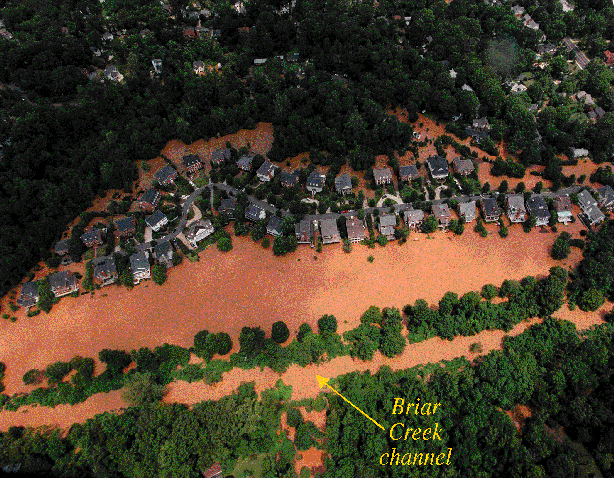In this report --
-
 Introduction
Introduction
-
 Rainfall in the City of Charlotte and Mecklenburg County During the Storms of August 26-28, 1995, and July 22-24, 1997
Rainfall in the City of Charlotte and Mecklenburg County During the Storms of August 26-28, 1995, and July 22-24, 1997
-
 Flooding in the City of Charlotte and Mecklenburg County as a Result of the Storms of August 26-28, 1995, and July 22-24, 1997
Flooding in the City of Charlotte and Mecklenburg County as a Result of the Storms of August 26-28, 1995, and July 22-24, 1997
-
 Effects of the August 26-28, 1995, and July 22-24, 1997, Storms on Water Quality
Effects of the August 26-28, 1995, and July 22-24, 1997, Storms on Water Quality
-
 References
References
Frequently asked questions --
-
 How can we have two "100-year floods" in less than two years?
How can we have two "100-year floods" in less than two years?
-
 What is a recurrence interval?
What is a recurrence interval?
-
 Does a 100-year storm always cause a 100-year flood?
Does a 100-year storm always cause a 100-year flood?
-
 How can the same streamflow be a 100-year flood at one location and only a 50-year flood at another?
How can the same streamflow be a 100-year flood at one location and only a 50-year flood at another?
-
 Determination of Peak Flows
Determination of Peak Flows
|
|
HOW CAN WE HAVE TWO "100-YEAR FLOODS" IN LESS THAN TWO YEARS?
This question points out the importance of proper terminology. The term "100-year flood" is used in an attempt to simplify the definition of a flood that statistically has a 1-percent chance of occurring in any given year. Likewise, the term "100-year storm" is used to define a rainfall event that statistically has this same 1-percent chance of occurring. In other words, over the course of 1 million years, these events would be expected to occur 10,000 times. The amount of rainfall in the city of Charlotte and Mecklenburg County and the subsequent flooding in August 1995 had no influence on the events of July 1997. These events, as well as any recurring events, are assumed to be statistically independent of each other.
Therefore, each year begins with the same 1-percent chance that a 100-year event will occur.
| Recurrence interval, in years |
Probability of occurrence in any given year |
Percent chance of occurrence in any given year |
|---|
|
| 1 in 100 |
| 1 in 50 |
| 1 in 25 |
| 1 in 10 |
| 1 in 5 |
| 1 in 2 |
|
|
|
 Flooded homes along Myers Park Drive when Briar Creek overflowed its banks.
(Photograph from The Charlotte Observer/Gary O'Brien)
Flooded homes along Myers Park Drive when Briar Creek overflowed its banks.
(Photograph from The Charlotte Observer/Gary O'Brien)